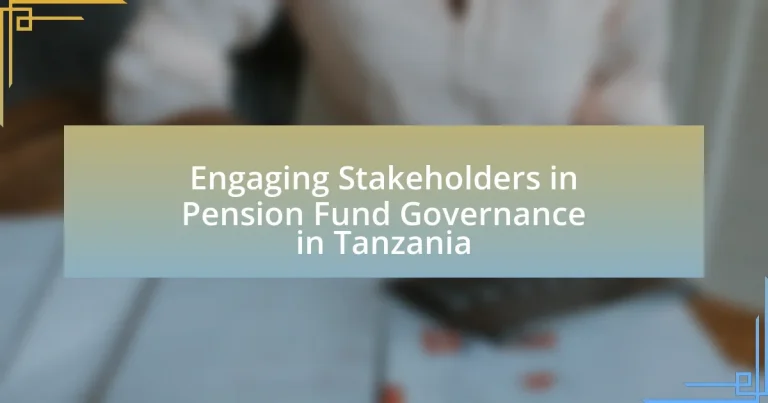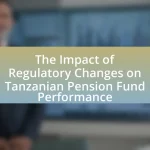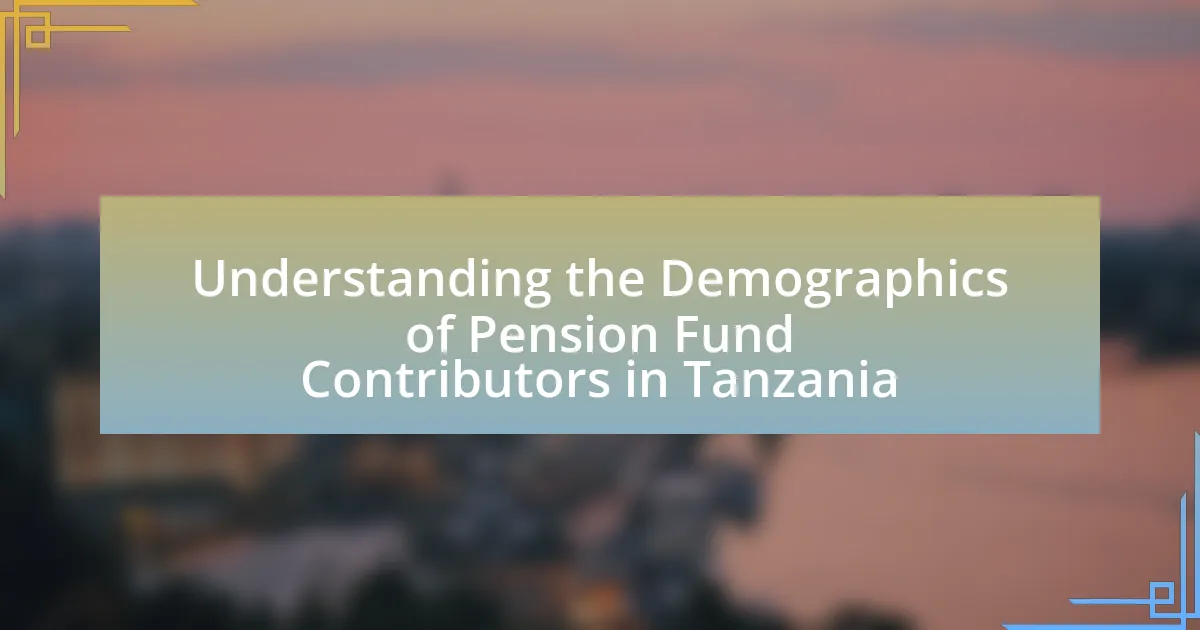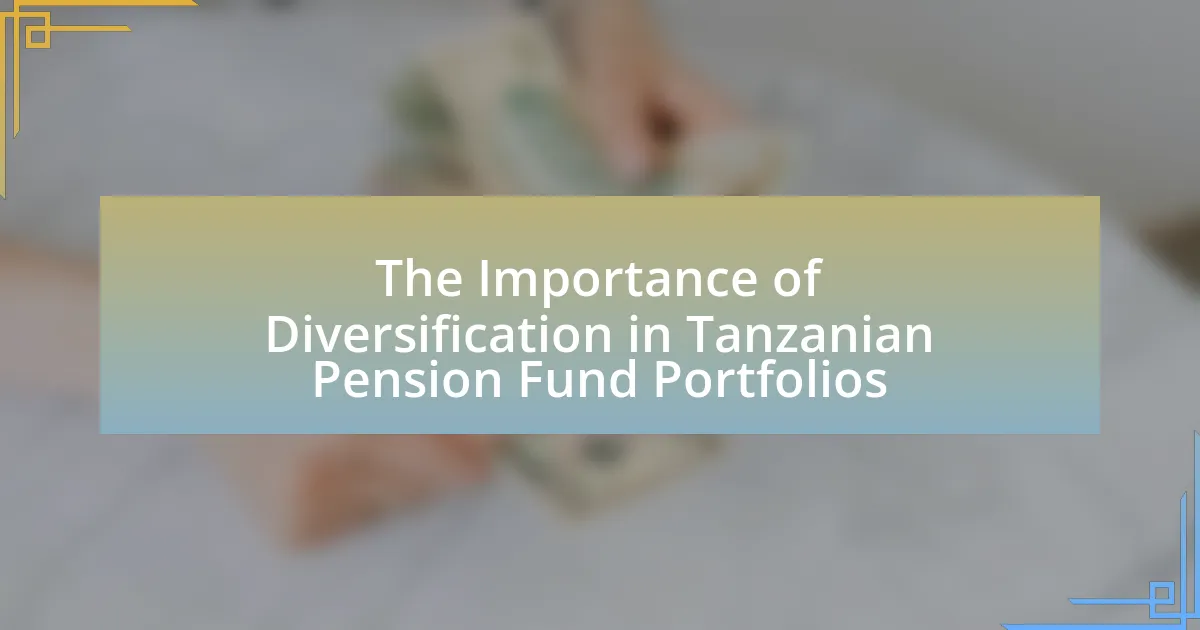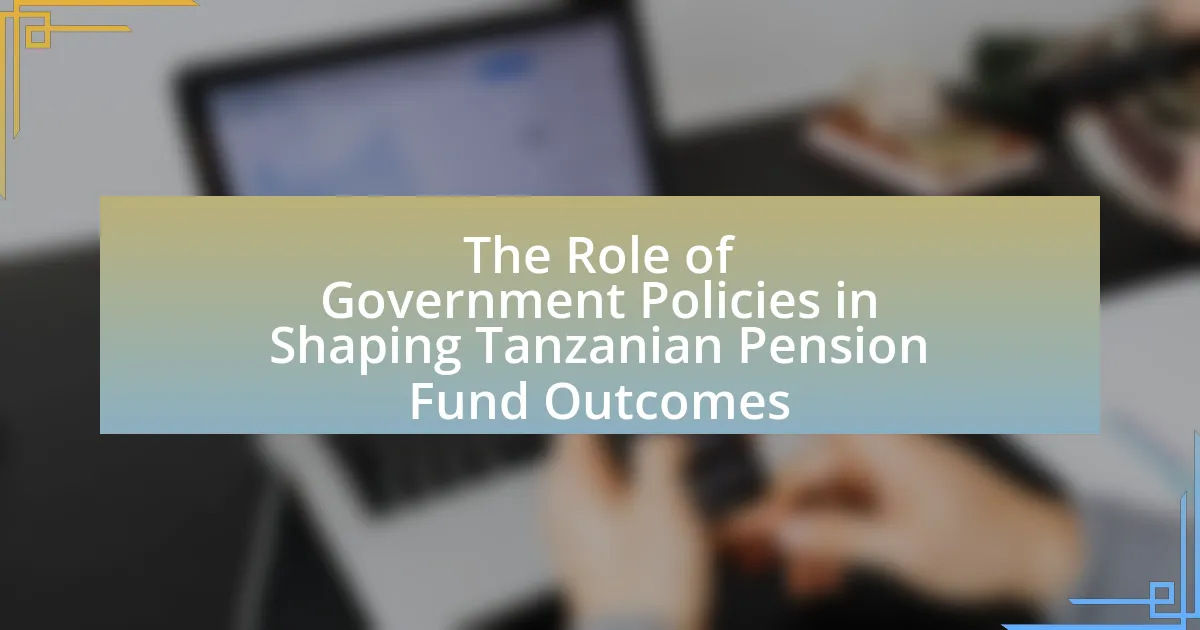Engaging stakeholders in pension fund governance in Tanzania is a critical process that involves the participation of government entities, pension fund managers, beneficiaries, and civil society organizations in decision-making. This engagement is essential for promoting transparency, accountability, and alignment with stakeholder interests, as exemplified by initiatives from the National Social Security Fund (NSSF). The article explores the importance of stakeholder engagement, the roles of various stakeholders, the challenges faced in Tanzania, and strategies to enhance participation. It also highlights the impact of cultural factors, communication methods, and technology on stakeholder engagement, ultimately demonstrating how effective engagement can lead to improved governance outcomes and better investment decisions in pension funds.

What is Engaging Stakeholders in Pension Fund Governance in Tanzania?
Engaging stakeholders in pension fund governance in Tanzania involves the active participation of various parties, including government entities, pension fund managers, beneficiaries, and civil society organizations, in decision-making processes related to pension fund management. This engagement is crucial for ensuring transparency, accountability, and the alignment of pension fund operations with the interests of all stakeholders. For instance, the National Social Security Fund (NSSF) in Tanzania has implemented stakeholder engagement initiatives to enhance governance and improve service delivery, reflecting a commitment to inclusive decision-making.
Why is stakeholder engagement important in pension fund governance?
Stakeholder engagement is crucial in pension fund governance because it ensures that the interests and concerns of all parties involved are considered in decision-making processes. Engaging stakeholders, such as beneficiaries, employers, and regulators, fosters transparency and accountability, which are essential for building trust in the governance of pension funds. Research indicates that effective stakeholder engagement can lead to better investment decisions and improved fund performance, as it allows for diverse perspectives and expertise to inform strategies. For instance, a study by the International Labour Organization highlights that inclusive governance structures enhance the sustainability and effectiveness of pension systems.
What roles do different stakeholders play in pension fund governance?
Different stakeholders play crucial roles in pension fund governance by influencing decision-making, ensuring accountability, and safeguarding beneficiaries’ interests. For instance, government regulators establish legal frameworks and oversight mechanisms to ensure compliance and protect members’ rights. Pension fund trustees are responsible for managing the fund’s assets and making investment decisions that align with the beneficiaries’ best interests. Additionally, employers contribute to the funding and may advocate for policies that benefit their employees. Beneficiaries, as the ultimate stakeholders, provide feedback and can influence governance through collective action. Research indicates that effective stakeholder engagement leads to improved governance outcomes, as seen in various pension systems globally, including those in Tanzania.
How does stakeholder engagement impact decision-making in pension funds?
Stakeholder engagement significantly enhances decision-making in pension funds by incorporating diverse perspectives and interests, which leads to more informed and balanced outcomes. Engaging stakeholders, such as beneficiaries, employers, and regulators, ensures that the fund’s strategies align with the needs and expectations of all parties involved. For instance, research indicates that pension funds that actively involve stakeholders in governance processes tend to achieve higher levels of transparency and accountability, ultimately fostering trust and improving investment performance. This collaborative approach not only mitigates risks associated with misalignment of interests but also promotes sustainable investment practices that reflect the values of the stakeholders, thereby enhancing the overall effectiveness of pension fund management.
What are the key challenges in engaging stakeholders in Tanzania?
The key challenges in engaging stakeholders in Tanzania include limited awareness of pension fund governance, lack of trust in institutions, and inadequate communication channels. Limited awareness results from insufficient education and outreach efforts, leading to stakeholders being uninformed about their rights and responsibilities. The lack of trust in institutions stems from historical governance issues and corruption, which diminishes stakeholder confidence in the system. Additionally, inadequate communication channels hinder effective dialogue between stakeholders and fund managers, preventing the exchange of vital information necessary for informed decision-making. These challenges collectively impede meaningful stakeholder engagement in pension fund governance in Tanzania.
What barriers exist to effective stakeholder engagement in pension fund governance?
Barriers to effective stakeholder engagement in pension fund governance include lack of transparency, insufficient communication, and limited stakeholder capacity. Lack of transparency often leads to distrust among stakeholders, as they may feel excluded from decision-making processes. Insufficient communication can result in stakeholders being unaware of their rights and responsibilities, hindering their ability to engage meaningfully. Limited stakeholder capacity, particularly among smaller or less organized groups, can prevent them from effectively participating in governance discussions. These barriers collectively undermine the potential for collaborative governance and informed decision-making in pension fund management.
How do cultural factors influence stakeholder engagement in Tanzania?
Cultural factors significantly influence stakeholder engagement in Tanzania by shaping communication styles, decision-making processes, and relationship-building practices. For instance, the collectivist nature of Tanzanian society emphasizes community and familial ties, which affects how stakeholders interact and collaborate. This cultural context leads to a preference for consensus-driven approaches, where decisions are made collectively rather than individually. Additionally, respect for elders and authority figures plays a crucial role in stakeholder dynamics, as these individuals often serve as key influencers in negotiations and discussions. Understanding these cultural nuances is essential for effective engagement, as they dictate the expectations and behaviors of stakeholders involved in pension fund governance.
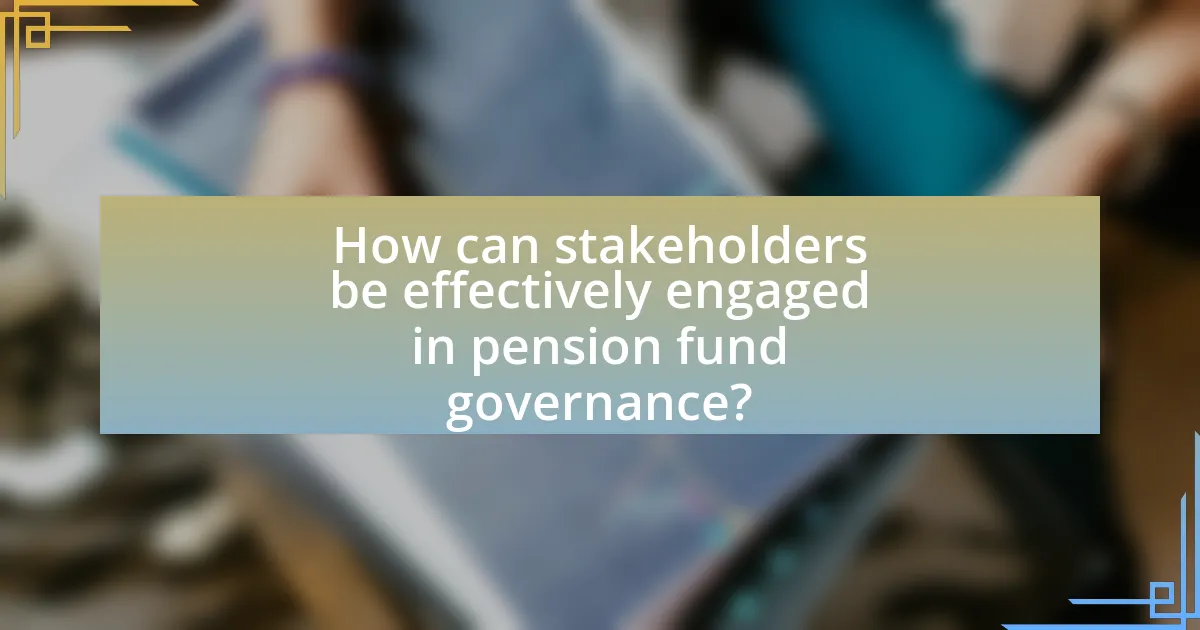
How can stakeholders be effectively engaged in pension fund governance?
Stakeholders can be effectively engaged in pension fund governance through structured communication, inclusive decision-making processes, and regular feedback mechanisms. Structured communication ensures that all stakeholders, including members, employers, and regulators, receive timely and relevant information about fund performance and governance changes. Inclusive decision-making processes involve stakeholders in key decisions, fostering a sense of ownership and accountability. Regular feedback mechanisms, such as surveys and consultations, allow stakeholders to express their views and influence governance practices. Research indicates that pension funds with active stakeholder engagement demonstrate improved transparency and trust, leading to better governance outcomes.
What strategies can be employed to enhance stakeholder participation?
To enhance stakeholder participation in pension fund governance in Tanzania, strategies such as inclusive communication, capacity building, and stakeholder mapping can be employed. Inclusive communication ensures that all stakeholders receive timely and relevant information, fostering transparency and trust. Capacity building involves training stakeholders to understand governance processes, enabling them to contribute effectively. Stakeholder mapping identifies key players and their interests, allowing for targeted engagement efforts. Research indicates that these strategies lead to increased participation and better decision-making outcomes in governance contexts, as evidenced by successful case studies in similar sectors.
How can technology facilitate stakeholder engagement in pension funds?
Technology can facilitate stakeholder engagement in pension funds by providing platforms for real-time communication and data sharing. Digital tools such as mobile applications and online portals enable stakeholders, including members and beneficiaries, to access information about fund performance, investment strategies, and governance processes. For instance, a study by the International Labour Organization highlights that digital engagement tools can increase transparency and trust, leading to higher participation rates in decision-making processes. Additionally, technology allows for the collection of stakeholder feedback through surveys and forums, which can be analyzed to improve fund management and responsiveness to member needs.
What role does communication play in engaging stakeholders?
Communication is essential in engaging stakeholders as it facilitates the exchange of information, builds trust, and fosters collaboration. Effective communication ensures that stakeholders are informed about decisions, policies, and changes within pension fund governance, which is crucial for their participation and support. For instance, studies show that transparent communication can lead to increased stakeholder satisfaction and commitment, as stakeholders feel valued and heard in the decision-making process. In the context of pension fund governance in Tanzania, regular updates and open dialogues can enhance stakeholder engagement, ultimately leading to better governance outcomes.
What best practices can be adopted for stakeholder engagement?
Best practices for stakeholder engagement in pension fund governance in Tanzania include establishing clear communication channels, involving stakeholders in decision-making processes, and ensuring transparency in operations. Clear communication channels facilitate the flow of information, allowing stakeholders to express their concerns and suggestions effectively. Involving stakeholders in decision-making fosters a sense of ownership and accountability, which is crucial for the success of pension fund initiatives. Transparency in operations builds trust and encourages active participation, as stakeholders are more likely to engage when they understand how decisions are made and how funds are managed. These practices are supported by research indicating that effective stakeholder engagement leads to improved governance outcomes and enhanced stakeholder satisfaction.
How can transparency be improved in pension fund governance?
Transparency in pension fund governance can be improved by implementing regular and detailed reporting practices. These practices should include clear disclosures of investment strategies, fees, and performance metrics, which allow stakeholders to understand how their funds are managed. For instance, the International Organization of Pension Supervisors emphasizes that transparency fosters trust and accountability, leading to better stakeholder engagement. Additionally, utilizing technology such as online dashboards can provide real-time access to fund performance and governance activities, further enhancing transparency.
What methods can be used to gather stakeholder feedback effectively?
To gather stakeholder feedback effectively, methods such as surveys, focus groups, interviews, and public consultations can be utilized. Surveys allow for quantitative data collection from a broad audience, while focus groups provide qualitative insights through in-depth discussions among selected stakeholders. Interviews facilitate personalized feedback, enabling deeper understanding of individual perspectives. Public consultations encourage open dialogue and collective input, fostering transparency and inclusivity. These methods are supported by research indicating that diverse feedback mechanisms enhance stakeholder engagement and improve decision-making processes in governance contexts, such as pension fund management in Tanzania.
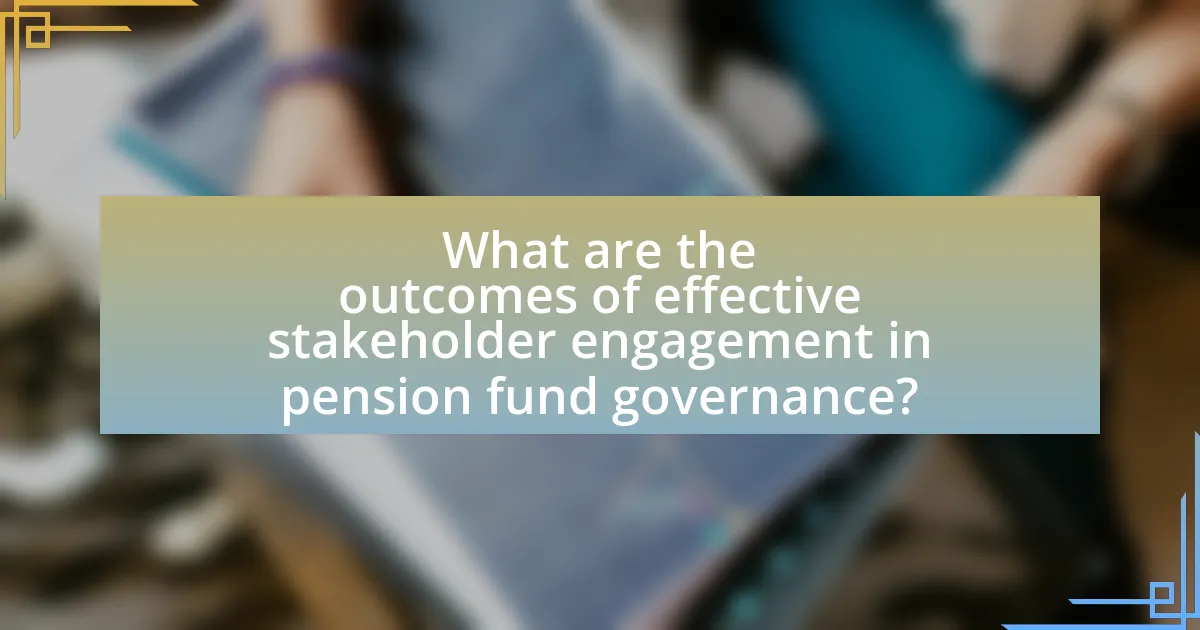
What are the outcomes of effective stakeholder engagement in pension fund governance?
Effective stakeholder engagement in pension fund governance leads to improved decision-making, enhanced transparency, and increased trust among stakeholders. Engaging stakeholders allows for diverse perspectives to be considered, which can result in more informed and balanced governance decisions. For instance, studies have shown that pension funds with active stakeholder participation tend to have better performance outcomes, as they align investment strategies with the interests of beneficiaries. Additionally, transparency in communication fosters accountability, which is crucial for maintaining stakeholder confidence. Research indicates that pension funds that prioritize stakeholder engagement experience lower levels of conflict and higher satisfaction rates among members, ultimately contributing to the long-term sustainability of the fund.
How does stakeholder engagement influence the performance of pension funds?
Stakeholder engagement significantly enhances the performance of pension funds by fostering transparency, accountability, and informed decision-making. Engaged stakeholders, including members, employers, and regulators, contribute diverse perspectives that lead to better governance practices and investment strategies. Research indicates that pension funds with active stakeholder participation tend to achieve higher returns and lower risks, as they are more responsive to the needs and concerns of their beneficiaries. For instance, a study by the International Labour Organization found that pension funds in countries with strong stakeholder engagement frameworks outperformed those with minimal engagement by an average of 15% over a decade. This correlation underscores the importance of involving stakeholders in the governance process to optimize fund performance.
What are the long-term benefits of engaging stakeholders in governance?
Engaging stakeholders in governance leads to enhanced decision-making and increased accountability. When stakeholders are involved, their diverse perspectives contribute to more informed and effective policies, which can improve the overall performance of governance structures. For instance, research indicates that stakeholder engagement fosters trust and collaboration, which are essential for sustainable governance outcomes. A study by the World Bank highlights that inclusive governance practices can lead to better resource allocation and improved service delivery, ultimately benefiting the community and enhancing the legitimacy of governance institutions.
How can stakeholder engagement lead to better investment decisions?
Stakeholder engagement can lead to better investment decisions by ensuring that diverse perspectives and insights are incorporated into the decision-making process. Engaging stakeholders, such as beneficiaries, fund managers, and community representatives, allows for a comprehensive understanding of the risks and opportunities associated with investments. For instance, research indicates that pension funds that actively involve stakeholders in governance processes tend to achieve higher long-term returns due to improved alignment with the interests of beneficiaries and enhanced risk management strategies. This collaborative approach fosters transparency and accountability, ultimately leading to more informed and effective investment choices.
What lessons can be learned from successful stakeholder engagement initiatives?
Successful stakeholder engagement initiatives demonstrate the importance of clear communication, inclusivity, and transparency. These elements foster trust and collaboration among stakeholders, which is essential for effective governance. For instance, initiatives that involve stakeholders in decision-making processes tend to yield better outcomes, as evidenced by the World Bank’s findings on participatory governance in pension fund management. Engaging stakeholders not only enhances accountability but also leads to more informed and sustainable decisions, as seen in various case studies across different sectors.
What case studies illustrate effective stakeholder engagement in Tanzania?
Case studies illustrating effective stakeholder engagement in Tanzania include the Tanzania Social Action Fund (TASAF) and the National Social Security Fund (NSSF) initiatives. TASAF has successfully engaged local communities in decision-making processes, leading to improved project outcomes and increased accountability. For instance, TASAF’s community-driven development approach has empowered beneficiaries to participate actively in project planning and implementation, resulting in enhanced service delivery. Similarly, the NSSF has implemented stakeholder consultations to gather input from members and employers, which has informed policy adjustments and improved fund management. These case studies demonstrate that structured engagement strategies can lead to better governance and stakeholder satisfaction in Tanzania’s pension fund landscape.
How can these lessons be applied to improve governance practices?
Lessons from engaging stakeholders in pension fund governance can be applied to improve governance practices by fostering transparency, accountability, and inclusivity. For instance, implementing regular stakeholder consultations can enhance decision-making processes, as evidenced by the World Bank’s findings that inclusive governance structures lead to better financial outcomes and stakeholder trust. Additionally, establishing clear communication channels between pension fund managers and beneficiaries can mitigate conflicts and align interests, as demonstrated in successful governance models in countries like Canada, where stakeholder engagement has resulted in higher satisfaction rates among fund participants.
What practical steps can be taken to enhance stakeholder engagement in Tanzania’s pension funds?
To enhance stakeholder engagement in Tanzania’s pension funds, implementing regular communication channels is essential. Establishing quarterly meetings and feedback sessions allows stakeholders to voice concerns and contribute ideas, fostering a collaborative environment. Additionally, utilizing digital platforms for information dissemination ensures transparency and accessibility, as evidenced by the increasing internet penetration in Tanzania, which reached 47% in 2022. Furthermore, conducting stakeholder surveys can identify specific needs and preferences, enabling pension funds to tailor their services effectively. These steps collectively promote active participation and strengthen the relationship between pension fund managers and stakeholders.
